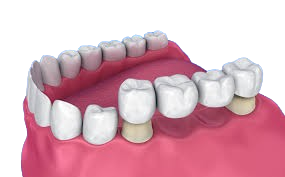Bridges

Dental bridges are a type of dental restoration used to replace one or more missing teeth by bridging the gap between adjacent teeth. They consist of artificial teeth, called pontics, which are anchored in place by crowns or metal framework attached to the natural teeth on either side of the gap.
Here's how dental bridges work?
- 1. Preparation:
The teeth on either side of the gap, called abutment teeth, are prepared by removing a small amount of enamel to accommodate the crowns that will support the bridge. If the abutment teeth are not healthy enough to support crowns, dental implants may be used instead.
-
2. Impressions:
Once the abutment teeth are prepared, impressions or digital scans of the mouth are taken to create a custom-made bridge that fits the patient's bite and matches the natural appearance of their teeth
. - 3. Temporary Bridge:
While the permanent bridge is being fabricated, a temporary bridge may be placed to protect the exposed teeth and gums.
- 4. Fitting:
Once the permanent bridge is ready, it is fitted and adjusted as needed to ensure proper fit and bite.
- 5. Placement:
The bridge is cemented or bonded into place, anchoring the pontic or artificial tooth in the gap between the abutment teeth.
Dental bridges offer several benefits, including:
-Restoring aesthetics by filling in gaps left by missing teeth.
- Improving chewing and speaking function.
- Preventing remaining teeth from shifting out of position.
- Distributing bite forces evenly across adjacent teeth.
There are different types of dental bridges, including traditional bridges, cantilever bridges, and Maryland bonded bridges, each with its own advantages and considerations. The type of bridge recommended will depend on factors such as the location of the missing teeth, the health of the surrounding teeth, and the patient's aesthetic preferences.
While dental bridges are a durable and long-lasting solution for tooth replacement, proper oral hygiene and regular dental check-ups are essential to maintain the health of the bridge and surrounding teeth.
FAQ
What is a dental bridge?
Who is a good candidate for a dental bridge?
How is a dental bridge placed?
Is the dental bridge procedure painful?
How long does it take to get a dental bridge?
What are the benefits of a dental bridge?
How do I care for a dental bridge?
Are dental bridges expensive?
Can a dental bridge be replaced?
Are there alternatives to dental bridges?
How much does a dental bridge cost?
Services
Dental services
know more about your treatment , symptons , procedure , costs and FAQ's.